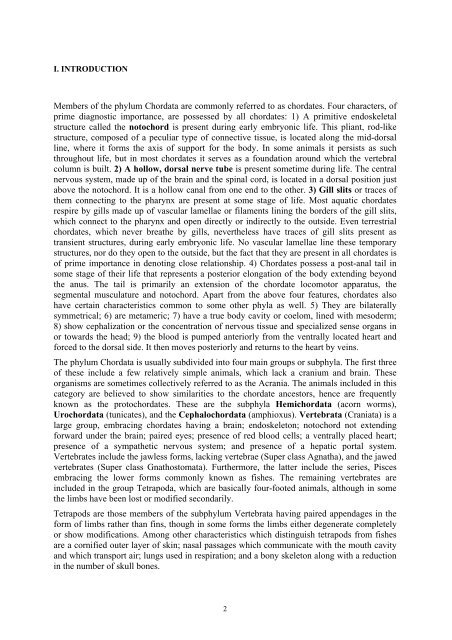Animal Diversity: Chordata
Animal Diversity: Chordata
Animal Diversity: Chordata
Create successful ePaper yourself
Turn your PDF publications into a flip-book with our unique Google optimized e-Paper software.
I. INTRODUCTION<br />
Members of the phylum <strong>Chordata</strong> are commonly referred to as chordates. Four characters, of<br />
prime diagnostic importance, are possessed by all chordates: 1) A primitive endoskeletal<br />
structure called the notochord is present during early embryonic life. This pliant, rod-like<br />
structure, composed of a peculiar type of connective tissue, is located along the mid-dorsal<br />
line, where it forms the axis of support for the body. In some animals it persists as such<br />
throughout life, but in most chordates it serves as a foundation around which the vertebral<br />
column is built. 2) A hollow, dorsal nerve tube is present sometime during life. The central<br />
nervous system, made up of the brain and the spinal cord, is located in a dorsal position just<br />
above the notochord. It is a hollow canal from one end to the other. 3) Gill slits or traces of<br />
them connecting to the pharynx are present at some stage of life. Most aquatic chordates<br />
respire by gills made up of vascular lamellae or filaments lining the borders of the gill slits,<br />
which connect to the pharynx and open directly or indirectly to the outside. Even terrestrial<br />
chordates, which never breathe by gills, nevertheless have traces of gill slits present as<br />
transient structures, during early embryonic life. No vascular lamellae line these temporary<br />
structures, nor do they open to the outside, but the fact that they are present in all chordates is<br />
of prime importance in denoting close relationship. 4) Chordates possess a post-anal tail in<br />
some stage of their life that represents a posterior elongation of the body extending beyond<br />
the anus. The tail is primarily an extension of the chordate locomotor apparatus, the<br />
segmental musculature and notochord. Apart from the above four features, chordates also<br />
have certain characteristics common to some other phyla as well. 5) They are bilaterally<br />
symmetrical; 6) are metameric; 7) have a true body cavity or coelom, lined with mesoderm;<br />
8) show cephalization or the concentration of nervous tissue and specialized sense organs in<br />
or towards the head; 9) the blood is pumped anteriorly from the ventrally located heart and<br />
forced to the dorsal side. It then moves posteriorly and returns to the heart by veins.<br />
The phylum <strong>Chordata</strong> is usually subdivided into four main groups or subphyla. The first three<br />
of these include a few relatively simple animals, which lack a cranium and brain. These<br />
organisms are sometimes collectively referred to as the Acrania. The animals included in this<br />
category are believed to show similarities to the chordate ancestors, hence are frequently<br />
known as the protochordates. These are the subphyla Hemichordata (acorn worms),<br />
Urochordata (tunicates), and the Cephalochordata (amphioxus). Vertebrata (Craniata) is a<br />
large group, embracing chordates having a brain; endoskeleton; notochord not extending<br />
forward under the brain; paired eyes; presence of red blood cells; a ventrally placed heart;<br />
presence of a sympathetic nervous system; and presence of a hepatic portal system.<br />
Vertebrates include the jawless forms, lacking vertebrae (Super class Agnatha), and the jawed<br />
vertebrates (Super class Gnathostomata). Furthermore, the latter include the series, Pisces<br />
embracing the lower forms commonly known as fishes. The remaining vertebrates are<br />
included in the group Tetrapoda, which are basically four-footed animals, although in some<br />
the limbs have been lost or modified secondarily.<br />
Tetrapods are those members of the subphylum Vertebrata having paired appendages in the<br />
form of limbs rather than fins, though in some forms the limbs either degenerate completely<br />
or show modifications. Among other characteristics which distinguish tetrapods from fishes<br />
are a cornified outer layer of skin; nasal passages which communicate with the mouth cavity<br />
and which transport air; lungs used in respiration; and a bony skeleton along with a reduction<br />
in the number of skull bones.<br />
2

















